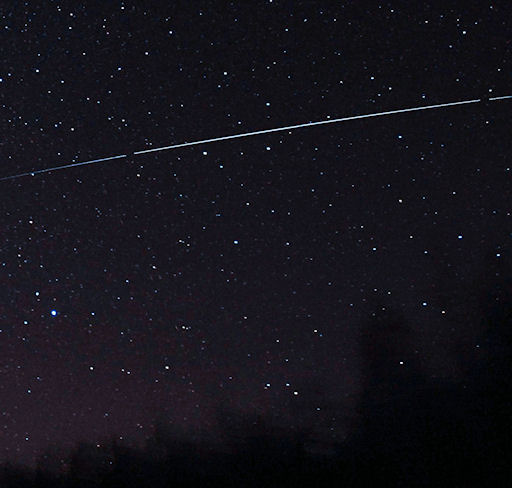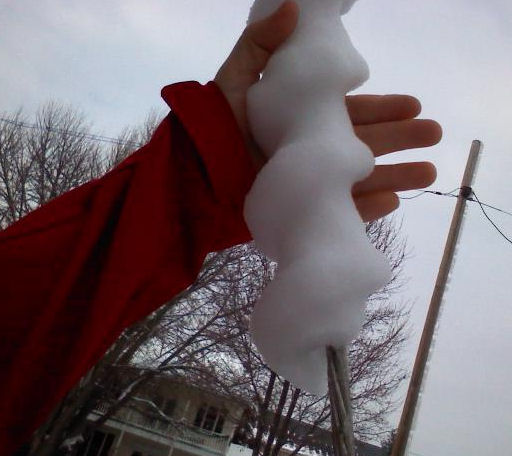Metallic photos of the sun by renowned photographer Greg Piepol bring together the best of art and science. Buy one or a whole set. They make a stellar gift. | | |
GEOMAGNETIC STORM WATCH: NOAA forecasters estimate a 60% chance of polar geomagnetic storms on Feb. 3rd when a coronal mass ejection is due to hit Earth's magnetic field. A solar wind stream following close behind the CME could extend the action into Feb. 4th and 5th. High-latitude sky watchers should be alert for auroras.
SOLAR SAIL FLARES: NASA's new solar sail, NanoSail-D, is circling Earth and attracting the attention of sky watchers--especially when it flares. Sunlight glinting off the sail's reflective fabric can rival the brightest stars, making a sudden and luminous streak across the night sky. Here it is over Rautalampi, Finland, on Jan. 30th:

Photo details: Nikon D70s, 18 mm/f/3.5, ISO 1600, 30 sec exposures
"At its peak, the flare was magnitude +3.5, easily seen with the naked eye," says photographer Vesa Vauhkonen. "I was able to photograph the event using an ordinary digital camera (a Nikon D70s)."
On the same night, NanoSail-D flared even more brightly over Helsinki, Finland. A meteor camera operated by Esko Lyytinen caught the sail flashing almost three times brighter than a 1st magnitude star: image.
Future flares could dwarf these. NanoSail-D is skimming the top of Earth's atmosphere and slowly descending as it circles the planet. As the spacecraft gets closer to Earth and aerodynamic forces flatten the fabric into an ever-better reflector, flares are likely to intensify, theoretically exceeding the brightness of Venus as much as 100-fold (5 magnitudes). Photograph one of those and you just might win $500.
more images: from Enzo De Bernardini of Buenos Aires, Argentina; from Arto Oksanen of Jyväskylä, Finland; from Mika Järvinen of Finland
SNOW SPIRALS--READER FEEDBACK: Regarding the snow spirals, described below, many readers have offered explanations for the phenomenon. Scroll to the bottom of the article for a summary.
SNOW SPIRALS: As a winter storm of historic proportions sweeps across the central USA this week, midwesterners should be alert for some unaccustomed sights. One of them is snow spirals. Michael French photographed this specimen in Frederick, Maryland, on Jan. 29th:

"I call them Karra Spirals, after my wife Karra Strickland who discovered them in our yard," says French. "They were all over town, spiraling down the braided metal guy-wires on telephone poles. Here's the curious thing: The wires were spun clockwise, while the snow formations were spun anti-clockwise. The hardened snow spirals were rotated opposite of the metal wire's weave. We also noticed that spirals near the top of the wires were longer (~1 meter) than spirals at the bottom (0.1 - 0.3 meters)--perhaps because of gravity?"
Indeed, the changing wavelength of the spiral suggests gravity played a role in their formation. This could be how heavy snow sags under its own weight when it clings to a braided wire. Why the spirals should oppose the braid, however, is not obvious. Readers with explanations are invited to submit them for consideration.
READER FEEDBACK (CONTINUED): A popular suggestion was that Coriolis forces twisted the snow around the wire. This cannot be correct because the scale of the phenomenon is too small for a significant Coriolis effect. Likewise, water swirling down the drain of your shower is not guided by the Coriolis force; hurricanes, however, are.
Many readers noticed that the swirl of the snow was perpendicular to the underlying braid of the wire. This observation led to the most elegant explanation: "As the snow slides down, it will follow the twist of the wire, hence the spiral builds up with the opposite twist," said reader Jim Easterbrook. Another reader, Uwe Heine, added that "snow sliding down compresses the snow ahead of it. As the spirals 'pile up' the 'wavelength' of the spirals gets shorter, hence the shorter spirals near the ground." Many correspondents echoed these ideas.
Other ideas involving wind and the circular vibration of the guy wire had merit, too, but we will give the last word to reader Matt Kolasinski: "I think it was a bunch of snow sprites having some fun, building their own version of a luge run." Case closed.
January 2011 Aurora Photo Gallery
[previous Januaries: 2010, 2009, 2008, 2007, 2005, 2004]

